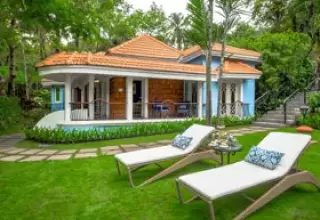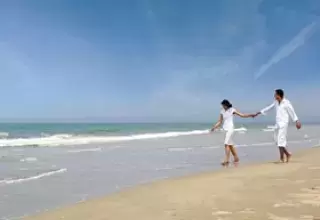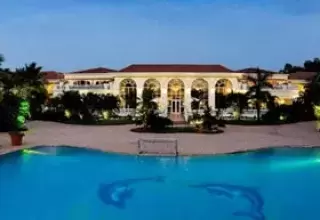

Vivanta by Taj Holiday Village Goa
Address: Sujan Singh Park, Subramaniam Bharti Marg, New Delhi, Delhi 110003
Best Goa Hotel Packages
Goa is the most popular holiday destinations in India for family holidays as well as the honeymooners.
It's Hard to tell where the coast ends and the towns begin in Goa. With more than 36 gorgeous beaches down the west side of its 2,295 square mi, this tiny state Tomasz (population 1.2 million)—a Portuguese colony until 1961—is India's d by most famous resort destination. With the exception of the monsoon season (June to September), the temperature stays warm and the air stays dry. Wide, palm-bordered rivers move lazily down to the Arabian Sea, and in small towns the houses gleam with a light wash of color set off by brightly painted front porches.
Goa was already a flourishing trade center before the arrival of the Portuguese in the sixteenth century—a marketplace for spices, silk, Persian corals, porcelain, and pearls. Yet ever since Alfonso de Albuquerque defeated Adil Shahi and established what turned out to be 450-year dominance, the Latin influence has defined Goan culture. The quintessential Goan is fun-loving and extroverted—Goans love a good drink and a hearty meal—yet always has time for an afternoon nap. Even today, most shopkeepers lower their shutters for a long siesta. Beer is cheap, and feni—cashew or coconut-palm hooch—is a favorite local drink at the state's 6,000 watering holes.
But the sweep of development and modernity is gradually undermining Goa's vestigial Portuguese culture in favor of Indian culture at large. Fewer houses and lodges begin their names with "Casa" or "Loja"; barbers are no longer known as barbarias, or tailors as alfaitarias. A few signs remain: HOSPICIO on the hospital in Margao, CINE NACIONAL on the movie theater in Panaji, and some shop signs with a Portuguese twist on common Hindu names, like POY for Pai, QUEXOVA for Keshava, and NAIQUE for Naik.
Although most travelers come to Goa for its beaches, both Margao, in the south, and the state capital of Panaji, farther north, are worth visiting for their sights alone. Panaji has whitewashed churches, palm-lined plazas, and clean streets and is a short taxi ride from the exquisitely beautiful Portuguese church town of Old Goa, the final resting place of St. Francis Xavier. Margao's Sunday food market is a chaotic spectacle, high-lighted by garrulous fisherwomen selling their fish out of baskets.
Architecture
Goa is best known for its grandiose churches, exquisitely sculpted temples, and mosques, all three to four centuries old. The most illustrious structures are Old Goa's se (cathedral) and Basilica of Born Jesus, where the remains of St. Francis Xavier lie in a silver casket entombed in a Florentine-style marble mausoleum.
Carnival
If you're here in February just before Lent, you'll see the Goans' zest for life in its finest form. Carnival time remains the official season for nonstop revelry, directed by King Momo ("King of Misrule"), a Goan appointed by his peers as the life of the party. Festivities include fanciful pageants (with some SO floats depicting elements of Goa's folk culture, or more contemporary messages like preservation of the environment), hordes of musicians strumming the guitar or playing the banjo, and dancers breaking into the mando (a folk fusion of the Portuguese fado and the waltz)—all in streets spangled with confetti. This is prime time to have a beer or a feni and savor Goa's legendary warmth.
Dining
The Goans' legendary passion for seafood is borne out in the lines of the state's Poet Laureate, B. B. Borkar: "0, God of Death! Don't make it my turn today, because there's fish curry for dinner!" Portuguese dishes are generally adapted to Goan tastes with a healthy pinch of red chili, tempered with coconut milk. Typical local dishes include zesty-sweet prawn-curry rice, chouris pao (sausage bread), chicken cafreal (amply seasoned with ginger, garlic, green chilis, and lime), and ultra-hot yin-daloo dishes. Goa's seafood is superb, especially fresh crabs, pomfret, squid, lobster, and prawns. Try pomfret in a red or green sauce, or tiger prawns haffad (in the spicy Goan style). For dessert, hehinka is a wonderfully rich layered pastry dense with butter, egg yolk, and coconut. And no Goan experience is truly complete without at least a taste of feni, the potent local brew made of either palm sap or cashew fruit.
Hotel
Most of Goa's ritziest hotels are in the South Goa ,Most popular being Leela Hotels , Taj Hotel and Resorts , Hotel Park Hyatt , Lalit Hotel , Alila Beach Resort , Azaya Beach Resort , Hotel Holiday Inn , Ramada hotel and many more , but you might want to try one of the little lodging houses that have sprung up along the coast in recent years. If you want to explore Old Goa, Panaji has several grand hotels, most notably the Hotel Fidalgo, complete with a shopping arcade that sells everything from postcards to pearls. From December to February, traveling hordes often fill the hotels, so he sure to reserve in advance. During the monsoon season, prices fall by up to half. Unless mentioned otherwise, hotels have central air-conditioning, room service, doctors on call, and currency-ex-change facilities, and rooms have cable TV and bathrooms with tubs.Most of the hotels and Resorts operate summer , monsoon and winter packages . Monsoon packages are generally discounted and some of the hotels also offer a night free package during this time .
Exploring Goa
Closest to the capital of Panaji (also called Panjim) are Miramar and Dona Paula beaches, both city beaches written up in tourist brochures. Avoid them. At Miramar, the swimming is marred by a strong under-tow, broken glass and garbage litter the sand, and some of the buildings are architectural eyesores. Dona Paula is a glorified cement dock crowded with vendors.
For the most seclusion, head north toward Arambol Beach, cloistered in cliffs (and popular with European hippies), or, farther south, to Palolem Beach or another less-developed beach below Colva. For pure beauty coupled with the comforts of a beach resort, opt for either Colva or Baga beach. If you want to windsurf or waterski, go to Sinquerim or Bogmalo beach, both an easy drive from Panaji. Surfers find that Goa's waves and wind generally only rise high enough during monsoon seasons.
Integral to the Goan beach experience are the vendors. You'll be approached constantly by men and women offering "Pineapples?" "Cheese?" "Cold drink?" "Drums?" Their persistence can drive you into the water. Nomadic Lambani women dressed in vibrant colors and silver jewelry set up blankets cluttered with handicrafts, jewelry, embroideries, and quilts.
For a slice of native Goan life, visit a weekly market. On Wednesday between September and May, vendors sell mostly Indian and Tibetan crafts and artifacts on Anjuna Beach, where a strong smell of fish fills the air. Friday is the big market day in Mapusa, the main town in the Bardez district; people from adjoining villages and even transplanted hippies convene to sell everything from vegetables to blue jeans to handicrafts. It's an ideal place to buy souvenirs.
When to Tour Goa
Goa can be enjoyed round the year , for foreigners ( because of high temperatures ) It's best to come to Goa in winter or early spring. During the rainy season, which stretches from the end of May to September, most beach-shack restaurants are closed due to heavy winds and violent surf. April and May are the best months for lolling around on the beach. If you come in early February, you'll experience the added excitement of Carnival.
Swan Tours, Delhi offers most of the hotels in Goa at discounted rates. The packages offered by Swan Tours may be inclusive of meals , airport transfers , hotel accommodation and much more, Family packages include special prices for accompanying children and Honeymoon packages would have inclusions such as Private Transfers and Sightseeing , Candle Lit Dinners ,etc for further details call Swan Tours , One of the leading Travel Agents in India.
© 2025 Swantour.com. All Rights Reserved. | Powered by Openlogic Systems






